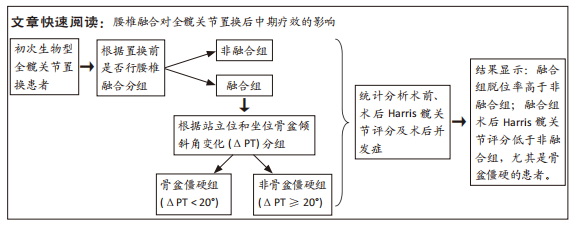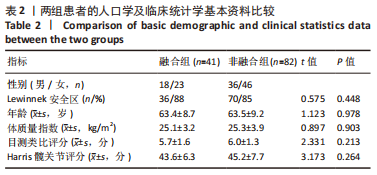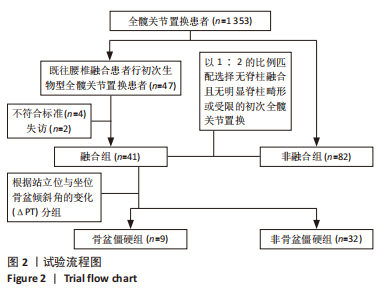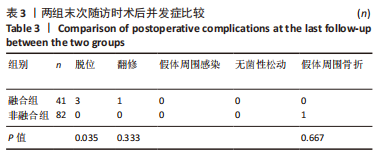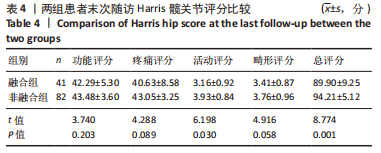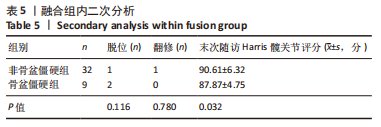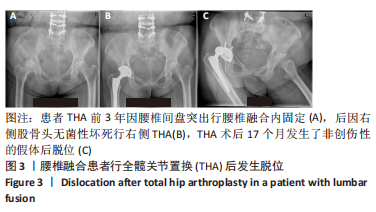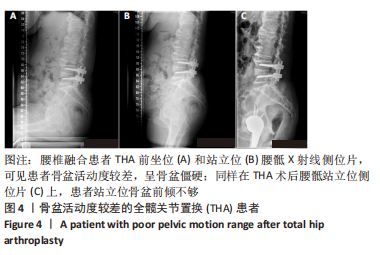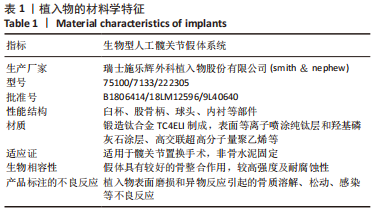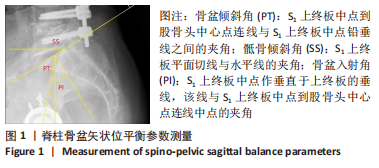[1] LUTHRINGER TA, VIGDORCHIK JM. A Preoperative Workup of a “Hip-Spine” Total Hip Arthroplasty Patient: A Simplified Approach to a Complex Problem. J Arthroplasty. 2019;34(7S):S57-S70.
[2] MALKANI AL, GARBER AT, ONG KL, et al. Total Hip Arthroplasty in Patients With Previous Lumbar Fusion Surgery: Are There More Dislocations and Revisions? J Arthroplasty. 2018;33(4):1189-1193.
[3] INNMANN MM, WEISHORN J, BEAULE PE, et al. Pathologic spinopelvic balance in patients with hip osteoarthritis : Preoperative screening and therapeutic implications. Orthopade. 2020;49(10):860-869.
[4] ESPOSITO CI, CARROLL KM, SCULCO PK, et al. Total Hip Arthroplasty Patients With Fixed Spinopelvic Alignment Are at Higher Risk of Hip Dislocation. J Arthroplasty. 2018;33(5):1449-1454.
[5] OFFIERSKI CM, MACNAB I. Hip-spine syndrome. Spine (Phila Pa 1976). 1983;8(3):316-321.
[6] BLIZZARD DJ, NICKEL BT, SEYLER TM, et al. The Impact of Lumbar Spine Disease and Deformity on Total Hip Arthroplasty Outcomes. Orthop Clin North Am. 2016;47(1):19-28.
[7] LOH JLM, JIANG L, CHONG HC, et al. Effect of Spinal Fusion Surgery on Total Hip Arthroplasty Outcomes: A Matched Comparison Study. J Arthroplasty. 2017;32(8): 2457-2461.
[8] HINMAN AD, INACIO MCS, PRENTICE HA, et al. Lumbar Spine Fusion Patients See Similar Improvements in Physical Activity Level to Non-Spine Fusion Patients Following Total Hip Arthroplasty. J Arthroplasty. 2020;35(2):451-456.
[9] YANG XT, HUANG HF, SUN L, et al. Direct Anterior Approach Versus Posterolateral Approach in Total Hip Arthroplasty: A Systematic Review and Meta-analysis of Randomized Controlled Studies. Orthop Surg. 2020;12(4):1065-1073.
[10] ONGGO JR, NAMBIAR M, ONGGO JD, et al. Comparable dislocation and revision rates for patients undergoing total hip arthroplasty with subsequent or prior lumbar spinal fusion: a meta-analysis and systematic review. Eur Spine J. 2021;30(1):63-70.
[11] GOYAL DKC, DIVI SN, VACCARO AR, et al. Stability in Direct Lateral vs Direct Anterior Total Hip Arthroplasty in the Context of Lumbar Spinal Fusion. J Am Acad Orthop Surg. 2022;30(7):e628-e639.
[12] KANAWADE V, DORR LD, WAN Z. Predictability of Acetabular Component Angular Change with Postural Shift from Standing to Sitting Position. J Bone Joint Surg Am. 2014;96(12):978-986.
[13] MARICONDA M, GALASSO O, COSTA GG, et al. Quality of life and functionality after total hip arthroplasty: a long-term follow-up study. BMC Musculoskelet Disord. 2011; 12:222.
[14] PATEL SA, LI NY, YANG DS, et al. Patients Who Undergo Primary Lumbar Spine Fusion After Recent but Not Remote Total Hip Arthroplasty Are at Increased Risk for Complications, Revision Surgery, and Prolonged Opioid Use. World Neurosurg. 2020; 144:e523-e532.
[15] MOHAMED NS, CASTRODAD IMD, ETCHESON JI, et al. Inpatient dislocation after primary total hip arthroplasty: incidence and associated patient and hospital factors. Hip Int. 2022;32(2):152-159.
[16] GAUSDEN EB, PARHAR HS, POPPER JE, et al. Risk Factors for Early Dislocation Following Primary Elective Total Hip Arthroplasty. J Arthroplasty. 2018;33(5):1567-1571.e1562.
[17] LAZENNEC JY, CHARLOT N, GORIN M, et al Hip-spine relationship: a radio-anatomical study for optimization in acetabular cup positioning. Surg Radiol Anat. 2004;26(2): 136-144.
[18] NIEMEIER TE, WILLS BW, THEISS SM, et al. Sagittal Pelvic Kinematics in Hip Arthroplasty. Curr Rev Musculoskelet Med. 2020;13(3):240-246.
[19] YH L, YT L, KH C. Paradoxical spinopelvic motion: does global balance influence spinopelvic motion in total hip arthroplasty?. BMC Musculoskelet Disord. 2021; 22(1):974.
[20] HAFFER H, ADL AMINI D, PERKA C, et al. The Impact of Spinopelvic Mobility on Arthroplasty: Implications for Hip and Spine Surgeons. J Clin Med. 2020;9(8):2569.
[21] VIGDORCHIK JM, SHARMA AK, DENNIS DA, et al. The Majority of Total Hip Arthroplasty Patients With a Stiff Spine Do Not Have an Instrumented Fusion. J Arthroplasty. 2020;35(6S): S252-S254.
[22] KATAKAM A, BEDAIR HS, MELNIC CM. Do All Rigid and Unbalanced Spines Present the Same Risk of Dislocation After Total Hip Arthroplasty? A Comparison Study Between Patients With Ankylosing Spondylitis and History of Spinal Fusion. J Arthroplasty. 2020;35(12):3594-3600.
[23] ONGGO JR, NAMBIAR M, ONGGO JD, et al. Clinical outcomes and complication profile of total hip arthroplasty after lumbar spine fusion: a meta-analysis and systematic review. Eur Spine J. 2020;29(2):282-294.
[24] UMEHARA S, ZINDRICK MR, PATWARDHAN AG, et al. The biomechanical effect of postoperative hypolordosis in instrumented lumbar fusion on instrumented and adjacent spinal segments. Spine. 2000;25(13):1617-1624.
[25] WENG W, WU H, WU M, et al. The effect of total hip arthroplasty on sagittal spinal-pelvic-leg alignment and low back pain in patients with severe hip osteoarthritis. Eur Spine J. 2016;25(11): 3608-3614.
[26] WENG WJ, WANG WJ, WU MD, et al. Characteristics of sagittal spine-pelvis-leg alignment in patients with severe hip osteoarthritis. Eur Spine J. 2015;24(6):1228-1236.
[27] CASAROLI G, BASSANI T, BRAYDA-BRUNO M, et al. What do we know about the biomechanics of the sacroiliac joint and of sacropelvic fixation? A literature review. Med Eng Phys. 2020;76:1-12.
[28] HAFFER H, ADL AMINI D, PERKA C, et al. The Impact of Spinopelvic Mobility on Arthroplasty: Implications for Hip and Spine Surgeons. J Clin Med. 2020;9(8):2569.
[29] ANDERSON PM, ARNHOLDT J, RUDERT M. Total Hip Arthroplasty After Spinal Fusion Surgery. Z Orthop Unfall. 2020;158(3):333-341.
[30] LE HUEC JC, FAUNDEZ A, DOMINGUEZ D, et al. Evidence showing the relationship between sagittal balance and clinical outcomes in surgical treatment of degenerative spinal diseases: a literature review. Int Orthop. 2015;39(1):87-95.
|
